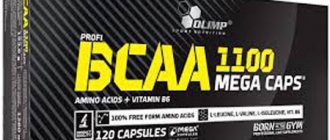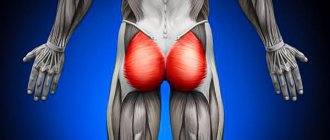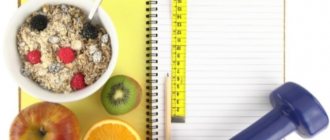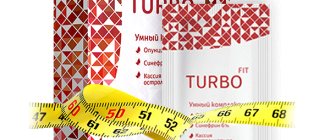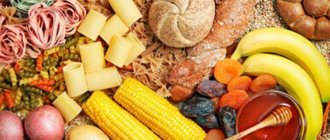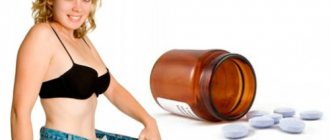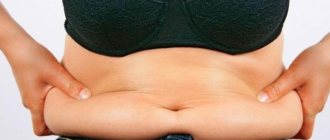Share:
Glycogen is a glucose-based polysaccharide that functions as an energy reserve in the body. The compound belongs to complex carbohydrates, is found only in living organisms and is intended to replenish energy expenditure during physical activity.
From the article you will learn about the functions of glycogen, the features of its synthesis, and the role this substance plays in sports and dietary nutrition.
What it is
In simple terms, glycogen (especially for an athlete) is an alternative to fatty acids that is used as a storage substance. The bottom line is that muscle cells have special energy structures - “glycogen depots”. They store glycogen, which, if necessary, quickly breaks down into simple glucose and supplies the body with additional energy.
In fact, glycogen is the main battery that is used exclusively for movement under stressful conditions.
How long does it take to spend?
- How food turns into fat: no, carbohydrates and sugar do not go into fat - 6 myths
- Which workout is better for losing weight and burning fat: strength training or cardio?
- What fruits can you eat while losing weight?
[Total votes: 5 Average: 5/5]
Bone Wide
This article was reviewed by a certified nutritionist who has a bachelor's degree in nutrition and dietetics, D. G. Veremeev.
Articles are for informational and educational purposes only and are not a substitute for professional medical advice, diagnosis, or treatment. Always consult your physician with any questions you may have about a medical condition.
Synthesis and transformation

Before considering the benefits of glycogen as a complex carbohydrate, let's figure out why such an alternative arises in the body - glycogen in muscles or adipose tissue. To do this, consider the structure of matter. Glycogen is a compound of hundreds of glucose molecules. In fact, it is pure sugar that is neutralized and does not enter the bloodstream until the body requests it (source - Wikipedia).
Glycogen is synthesized in the liver, which processes incoming sugar and fatty acids at its discretion.
Fatty acid
What is a fatty acid that comes from carbohydrates? In fact, this is a more complex structure in which not only carbohydrates are involved, but also transporting proteins. The latter bind and compact glucose to a more difficult to break down state.
This, in turn, allows you to increase the energy value of fats (from 300 to 700 kcal) and reduce the likelihood of accidental breakdown.
All this is done solely to create an energy reserve in case of a serious calorie deficit. Glycogen accumulates in cells and breaks down into glucose at the slightest stress. But its synthesis is much simpler.
Glycogen content in the human body
How much glycogen can the body contain? It all depends on training your own energy systems. Initially, the size of the glycogen depot of an untrained person is minimal, which is due to his motor needs.
Subsequently, after 3-4 months of intense high-volume training, the glycogen depot gradually increases under the influence of pumping, blood saturation and the principle of super recovery.
With intense and prolonged training, glycogen reserves in the body increase several times.
This, in turn, leads to the following results:
- endurance increases;
- the volume of muscle tissue increases;
- there are significant fluctuations in weight during the training process
Glycogen does not directly affect an athlete’s strength performance. In addition, to increase the size of the glycogen depot, special training is needed. For example, powerlifters are deprived of significant glycogen reserves due to the characteristics of the training process.
Dependence of fat burning on glycogen
For an hour of physical aerobic and anaerobic activity, the body requires about 100-150 grams of glycogen. When the available reserves of this substance are exhausted, a sequence enters into a reaction involving the destruction of first muscle fibers and then adipose tissue.
To get rid of excess fat, it is most effective to exercise after a long break since your last meal, when glycogen stores are depleted, for example, on an empty stomach in the morning. You need to train at an average pace to lose weight.
Functions of glycogen in the human body

Glycogen exchange occurs in the liver. Its main function is not to convert sugar into useful nutrients, but to filter and protect the body. In fact, the liver reacts negatively to increased blood sugar, saturated fatty acids, and exercise.
All this physically destroys liver cells, which, fortunately, regenerate.
Excessive consumption of sweets (and fatty foods), combined with intense physical activity, is fraught not only with pancreatic dysfunction and liver problems, but also with serious metabolic disorders of the liver.
The body always tries to adapt to changing conditions with minimal energy loss.
If you create a situation in which the liver (capable of processing no more than 100 grams of glucose at a time) chronically experiences an excess of sugar, then the new restored cells will convert sugar directly into fatty acids, bypassing the glycogen stage.
This process is called “fatty liver.” With complete fatty degeneration, hepatitis occurs. But partial degeneration is considered the norm for many weightlifters: such a change in the role of the liver in glycogen synthesis leads to a slowdown in metabolism and the appearance of excess fat.
In addition, regardless of the nature of physical activity and its presence in general, fatty liver is the basis for the formation of:
- metabolic syndrome;
- atherosclerosis and its complications such as heart attack, stroke, embolism;
- diabetes mellitus;
- arterial hypertension;
- coronary heart disease.
In addition to changes in the liver and cardiovascular system, excess glycogen causes:
- blood thickening and possible subsequent thrombosis;
- dysfunction at any level of the gastrointestinal tract;
- obesity.
On the other hand, glycogen deficiency is no less dangerous. Since this carbohydrate is the main source of energy, its deficiency can cause:
- deterioration of memory, perception of information;
- constant bad mood, apathy, which leads to the formation of various depressive syndromes;
- general weakness, lethargy, decreased ability to work, which affects the results of any daily human activity;
- weight loss due to loss of muscle mass;
- weakening of muscle tone up to the development of atrophy.
Lack of glycogen in athletes often manifests itself as a decrease in the frequency and duration of training, and a decrease in motivation.
Synthesizing
Glycogen is a strategic reserve of energy that is synthesized in the body from carbohydrates.
First, the body uses the carbohydrates received for strategic purposes, and stores the remainder “for a rainy day.” Energy deficiency is the reason for the breakdown of glycogen into the state of glucose.
The synthesis of the substance is regulated by hormones and the nervous system. This process, particularly in the muscles, is “triggered” by adrenaline. And the breakdown of animal starch in the liver activates the hormone glucagon (produced by the pancreas during fasting). The hormone insulin is responsible for the synthesis of “reserve” carbohydrates. The process consists of several stages and occurs exclusively during meals.
Glycogen reserves and sports

Glycogen in the body serves as the main energy carrier. It accumulates in the liver and muscles, from where it directly enters the circulatory system, providing us with the necessary energy (source - NCBI - National Center for Biotechnology Information).
Let's look at how glycogen directly affects an athlete's performance:
- Glycogen is quickly depleted due to exercise. In fact, in one intense workout you can waste up to 80% of your total glycogen.
- This in turn causes a “carbohydrate window” when the body requires fast carbohydrates for recovery.
- Under the influence of filling the muscles with blood, the glycogen depot stretches, increasing the size of the cells that can store it.
- Glycogen enters the blood only until the pulse crosses the mark of 80% of the maximum heart rate. If this threshold is exceeded, the lack of oxygen leads to rapid oxidation of fatty acids. “Drying the body” is based on this principle.
- Glycogen does not affect strength indicators - only endurance.
Interesting fact: during the carbohydrate window, you can safely consume any amount of sweet and unhealthy foods, since the body first of all restores glycogen storage.
The relationship between glycogen and athletic performance is extremely simple. The more repetitions - more exhaustion, more glycogen in the future, which means more repetitions in the end.
Use for weight loss
It's important to know why low-carb, high-protein diets work. An adult’s body can contain about 400 grams of glycogen, and as we remember, for every gram of reserve glucose there is approximately 4 grams of water.
Those. about 2 kg of your weight is the mass of glycogen aqueous solution. By the way, this is why we actively sweat during training - the body breaks down glycogen and at the same time loses 4 times more fluid.
This property of glycogen also explains the quick results of express diets for weight loss. Low-carbohydrate diets provoke intensive consumption of glycogen, and with it fluids from the body.
But as soon as a person returns to a normal diet containing carbohydrates, animal starch reserves are restored, and with them the liquid lost during the diet.
This is the reason for the short-term results of express weight loss.
Glycogen and weight loss
Unfortunately, the accumulation of glycogen does not contribute to weight loss. However, you should not give up training and go on a diet.
Let's take a closer look at the situation. Regular training leads to an increase in glycogen storage.
In total, over a year it can increase by 300-600%, which is expressed in a 7-12% increase in total weight. Yes, these are the same kilograms that many women strive to escape.
But on the other hand, these kilograms do not settle on the sides, but remain in the muscle tissue, which leads to an increase in the muscles themselves. For example, gluteals.
In turn, the presence and depletion of glycogen depot allows the athlete to adjust his weight in a short time.
For example, if you need to lose an additional 5-7 kilograms in a few days, depleting your glycogen depot with serious aerobic exercise will help you quickly get into the weight category.
Another important feature of the breakdown and accumulation of glycogen is the redistribution of liver functions. In particular, with an increased size of the depot, excess calories are bound into carbohydrate chains without converting them into fatty acids. What does it mean? It's simple - a trained athlete is less likely to gain fat. Thus, even among venerable bodybuilders, whose weight in the off-season reaches 140-150 kg, the percentage of body fat rarely reaches 25-27% (source - NCBI - National Center for Biotechnology Information).
Glycogenosis and other disorders
In some cases, glycogen breakdown does not occur; the substance accumulates in the tissues and cells of all organs. The phenomenon occurs in genetic disorders - dysfunction of enzymes that break down substances. The pathology is called glycogenesis and is an autosomal recessive disorder. The clinical picture describes 12 types of the disease, but half of them remain poorly studied.
Glycogen disorders include aglycogenesis, the absence of the enzyme responsible for glycogen synthesis. Symptoms: convulsions, hypoglycemia. Diagnosed by liver biopsy.

Glycogen reserves from muscles and liver are extremely important for athletes; increasing glycogen depot is a necessity and prevention of obesity. Energy system training helps achieve athletic performance and goals by increasing daily energy reserves. You will forget about fatigue and stay in good shape for a long time. Approach your training and nutrition wisely!
Factors affecting glycogen levels
It is important to understand that it is not only training that affects the amount of glycogen in the liver. This is also facilitated by the basic regulation of the hormones insulin and glucagon, which occurs through the consumption of a certain type of food.
Thus, fast carbohydrates, when the body is generally saturated, will most likely turn into adipose tissue, and slow carbohydrates will completely turn into energy, bypassing glycogen chains.
So how can you correctly determine how the food you eat will be distributed?
To do this, the following factors must be taken into account:
- Glycemic index. High levels contribute to an increase in blood sugar, which urgently needs to be preserved in fats. Low levels stimulate a gradual increase in glucose in the blood, which contributes to its complete breakdown. And only average values (from 30 to 60) contribute to the conversion of sugar into glycogen.
- Glycemic load. The relationship is inversely proportional. The lower the load, the greater the chance of converting carbohydrates into glycogen.
- The type of carbohydrate itself. It all depends on how easily the carbohydrate compound is broken down into simple monosaccharides. For example, maltodextrin is more likely to turn into glycogen, although it has a high glycemic index. This polysaccharide goes directly to the liver, bypassing the digestive process, and in this case it is easier to break it down into glycogen than to turn it into glucose and reassemble the molecule again.
- Amount of carbohydrates. If you correctly dose the amount of carbohydrates per meal, then even eating chocolates and muffins you will be able to avoid fat deposits.
Stages of glycogen formation
So, what happens during the synthesis of glycogen from glucose?
1. Glucose, after adding a phosphoric acid residue, becomes glucose-6-phosphate. This occurs thanks to the enzyme hexokinase. This enzyme has several different forms. Hexokinase in muscle is slightly different from hexokinase in liver. The form of this enzyme that is present in the liver binds worse to glucose, and the product formed during the reaction does not inhibit the reaction. Thanks to this, liver cells are able to absorb glucose only when there is a lot of it, and can immediately convert a lot of substrate into glucose-6-phosphate, even if they do not have time to process it.
2. The enzyme phosphoglucomutase catalyzes the conversion of glucose-6-phosphate into its isomer, glucose-1-phosphate.
3. The resulting glucose-1-phosphate then combines with uridine triphosphate to form UDP-glucose. This process is catalyzed by the enzyme UDP-glucose pyrophosphorylase. This reaction cannot proceed in the opposite direction, that is, it is irreversible under the conditions present in the cell.
4. The enzyme glycogen synthase transfers the remaining glucose to the forming glycogen molecule.
5. Glycogen branching enzyme adds branch points, creating new “branches” on the glycogen molecule. Later, new glucose residues are added to the end of this branch by glycogen synthase.
Table of probability of converting carbohydrates into glycogen
So, carbohydrates are unequal in their ability to convert into glycogen or into polyunsaturated fatty acids. What the incoming glucose will turn into depends only on the quantity in which it is released during the breakdown of the product. For example, very slow carbohydrates are very likely not to be converted into fatty acids or glycogen at all. At the same time, pure sugar will go into the fat layer almost entirely.
Editor's note: The list of products below should not be considered the ultimate truth. Metabolic processes depend on the individual characteristics of a particular person. We are only reporting the percentage chance that this product will be better or worse for you.
| Name | Glycemic index | Percentage probability of complete combustion | Percentage chance of turning into fat | Percentage probability of conversion to glycogen |
| Dried dates | 204 | 3.7% | 62.4% | <10% |
| Fresh dates | 202 | 2.5% | 58.5% | <10% |
| Dry sunflower seeds | 8 | 85% | 28.8% | 7% |
| Peanut | 20 | 65% | 8.8% | 7% |
| Broccoli | 20 | 65% | 2.2% | 7% |
| Mushrooms | 20 | 65% | 2.2% | 7% |
| Leaf lettuce | 20 | 65% | 2.4% | 7% |
| Lettuce | 20 | 65% | 0.8% | 7% |
| Tomatoes | 20 | 65% | 4.8% | 7% |
| Eggplant | 20 | 65% | 5.2% | 7% |
| Green pepper | 20 | 65% | 5.4% | 7% |
| White cabbage | 20 | 65% | 4.6% | 7% |
| Garlic | 20 | 65% | 5.2% | 7% |
| Bulb onions | 20 | 65% | 8.2% | 7% |
| Fresh apricots | 20 | 65% | 8.0% | 7% |
| Fructose | 20 | 65% | 88.8% | 7% |
| Plums | 22 | 65% | 8.5% | 7% |
| Pearl barley | 22 | 65% | 24% | 7% |
| Grapefruits | 22 | 65% | 5.5% | 7% |
| Cherry | 22 | 65% | 22.4% | 7% |
| Dark chocolate (60% cocoa) | 22 | 65% | 52.5% | 7% |
| Walnuts | 25 | 37% | 28.4% | 27% |
| Skim milk | 26 | 37% | 4.6% | 27% |
| Sausages | 28 | 37% | 0.8% | 27% |
| Grape | 40 | 37% | 25.0% | 27% |
| Fresh green peas | 40 | 37% | 22.8% | 27% |
| Freshly squeezed orange juice without sugar | 40 | 37% | 28% | 27% |
| Milk 2.5% | 40 | 37% | 4.64% | 27% |
| Apples | 40 | 37% | 8.0% | 27% |
| Apple juice without sugar | 40 | 37% | 8.2% | 27% |
| Mamalyga (corn flour porridge) | 40 | 37% | 22.2% | 27% |
| White beans | 40 | 37% | 22.5% | 27% |
| Wheat grain bread, rye bread | 40 | 37% | 44.8% | 27% |
| Peaches | 40 | 37% | 8.5% | 27% |
| Berry marmalade without sugar, jam without sugar | 40 | 37% | 65% | 27% |
| Soy milk | 40 | 37% | 2.6% | 27% |
| Whole milk | 42 | 37% | 4.6% | 27% |
| Strawberry | 42 | 37% | 5.4% | 27% |
| Boiled colored beans | 42 | 37% | 22.5% | 27% |
| Canned pears | 44 | 37% | 28.2% | 27% |
| Pears | 44 | 37% | 8.5% | 27% |
| Rye grains. sprouted | 44 | 37% | 56.2% | 27% |
| Natural yoghurt 4.2% fat | 45 | 37% | 4.5% | 27% |
| Low fat yogurt | 45 | 37% | 4.5% | 27% |
| Bran bread | 45 | 37% | 22.4% | 27% |
| Pineapple juice. sugarless | 45 | 37% | 25.6% | 27% |
| Dried apricots | 45 | 37% | 55% | 27% |
| Raw carrots | 45 | 37% | 6.2% | 27% |
| Oranges | 45 | 37% | 8.2% | 27% |
| Figs | 45 | 37% | 22.2% | 27% |
| Oatmeal porridge milk | 48 | 37% | 24.2% | 27% |
| Green peas. canned | 48 | 31% | 5.5% | 42% |
| Grape juice without sugar | 48 | 31% | 24.8% | 42% |
| Wholemeal spaghetti | 48 | 31% | 58.4% | 42% |
| Grapefruit juice without sugar | 48 | 31% | 8.0% | 42% |
| Sherbet | 50 | 31% | 84% | 42% |
| Kiwi | 50 | 31% | 4.0% | 42% |
| Bread, pancakes made from buckwheat flour | 50 | 31% | 44.2% | 42% |
| Sweet potatoes (yam) | 50 | 31% | 24.5% | 42% |
| Tortellini with cheese | 50 | 31% | 24.8% | 42% |
| Crumbled buckwheat | 50 | 31% | 40.5% | 42% |
| Spaghetti. pasta | 50 | 31% | 58.4% | 42% |
| White fluffy rice | 50 | 31% | 24.8% | 42% |
| Pizza with tomatoes and cheese | 50 | 31% | 28.4% | 42% |
| Hamburger buns | 52 | 31% | 54.6% | 42% |
| Twix | 52 | 31% | 54% | 42% |
| Sweet yoghurt | 52 | 31% | 8.5% | 42% |
| Ice cream sundae | 52 | 31% | 20.8% | 42% |
| Wheat flour pancakes | 52 | 31% | 40% | 42% |
| Bran | 52 | 31% | 24.5% | 42% |
| Biscuit | 54 | 31% | 54.2% | 42% |
| Raisin | 54 | 31% | 55% | 42% |
| Shortbread cookies | 54 | 31% | 65.8% | 42% |
| Beet | 54 | 31% | 8.8% | 42% |
| Pasta with cheese | 54 | 31% | 24.8% | 42% |
| Wheat grains. sprouted | 54 | 31% | 28.2% | 42% |
| Beer 2.8% alcohol | 220 | 20% | 4.4% | <10% |
| Semolina | 55 | 12% | 56.6% | <10% |
| Oatmeal, instant | 55 | 12% | 55% | <10% |
| Butter cookies | 55 | 12% | 65. 8% | <10% |
| Orange juice (ready) | 55 | 12% | 22.8% | <10% |
| Fruit salad with whipped cream and sugar | 55 | 12% | 55.2% | <10% |
| Couscous | 55 | 12% | 64% | <10% |
| Oatmeal cookies | 55 | 12% | 62% | <10% |
| Mango | 55 | 12% | 22.5% | <10% |
| A pineapple | 55 | 12% | 22.5% | <10% |
| Black bread | 55 | 12% | 40.6% | <10% |
| bananas | 55 | 12% | 22% | <10% |
| Melon | 55 | 12% | 8.2% | <10% |
| Potato. boiled "in its uniform" | 55 | 12% | 40.4% | <10% |
| Boiled wild rice | 56 | 12% | 22.44% | <10% |
| Croissant | 56 | 12% | 40.6% | <10% |
| Wheat flour | 58 | 12% | 58.8% | <10% |
| Papaya | 58 | 12% | 8.2% | <10% |
| Canned corn | 58 | 12% | 22.2% | <10% |
| Marmalade, jam with sugar | 60 | 12% | 60% | <10% |
| Milk chocolate | 60 | 12% | 52.5% | <10% |
| Potato starch, corn starch | 60 | 12% | 68.2% | <10% |
| Steamed white rice | 60 | 12% | 68.4% | <10% |
| Sugar (sucrose) | 60 | 12% | 88.8% | <10% |
| Dumplings, ravioli | 60 | 12% | 22% | <10% |
| Coca-Cola, Fanta, Sprite | 60 | 12% | 42% | <10% |
| Mars, Snickers (bars) | 60 | 12% | 28% | <10% |
| Boiled potatoes | 60 | 12% | 25.6% | <10% |
| Boiled corn | 60 | 12% | 22.2% | <10% |
| Wheat bagel | 62 | 12% | 58.5% | <10% |
| Millet | 62 | 12% | 55.5% | <10% |
| Ground breadcrumbs for breading | 64 | 12% | 62.5% | <10% |
| Unsweetened waffles | 65 | 12% | 80.2% | <10% |
| Pumpkin | 65 | 12% | 4.4% | <10% |
| Watermelon | 65 | 12% | 8.8% | <10% |
| Donuts | 65 | 12% | 48.8% | <10% |
| Zucchini | 65 | 12% | 4.8% | <10% |
| Muesli with nuts and raisins | 80 | 12% | 55.4% | <10% |
| Potato chips | 80 | 12% | 48.5% | <10% |
| Crackers | 80 | 12% | 55.2% | <10% |
| Instant rice porridge | 80 | 12% | 65.2% | <10% |
| Honey | 80 | 12% | 80.4% | <10% |
| Mashed potatoes | 80 | 12% | 24.4% | <10% |
| Jam | 82 | 12% | 58% | <10% |
| Canned apricots | 82 | 12% | 22% | <10% |
| Instant mashed potatoes | 84 | 12% | 45% | <10% |
| Baked potatoes | 85 | 12% | 22.5% | <10% |
| White bread | 85 | 12% | 48.5% | <10% |
| Pop corn | 85 | 12% | 62% | <10% |
| Cornflakes | 85 | 12% | 68.5% | <10% |
| French buns | 85 | 12% | 54% | <10% |
| Rice flour | 85 | 12% | 82.5% | <10% |
| Boiled carrots | 85 | 12% | 28% | <10% |
| white bread toast | 200 | 7% | 55% | <10% |
What is it in biology: biological role
Our body needs food first of all as a source of energy, and only then as a source of pleasure, an anti-stress shield or an opportunity to “pamper” itself. As you know, we get energy from macronutrients: fats , proteins and carbohydrates .
Fats provide 9 kcal, and proteins and carbohydrates provide 4 kcal. But despite the high energy value of fats and the important role of essential amino acids from proteins, carbohydrates are the most important “suppliers” of energy to our body.
Why? The answer is simple: fats and proteins are a “slow” form of energy, because... their fermentation requires a certain time, and carbohydrates are relatively “fast” . All carbohydrates (be it candy or bran bread) are eventually broken down into glucose , which is necessary to nourish all cells of the body.

Carbohydrate breakdown scheme
Structure
Glycogen is a kind of “preservative” of carbohydrates, in other words, the body’s energy reserves - glucose stored in reserve for subsequent energy needs. It is stored in a water-bound state. Those. glycogen is a “syrup” with a calorie content of 1-1.3 kcal/g (with a calorie content of carbohydrates of 4 kcal/g).
In fact, the glycogen molecule consists of glucose residues; it is a reserve substance in case of lack of energy in the body!
The structural formula for the structure of a fragment of the glycogen macromolecule (C6H10O5) looks schematically like this:

What type of carbohydrates is it?
In general, glycogen is a polysaccharide, which means it belongs to the class of “complex” carbohydrates:
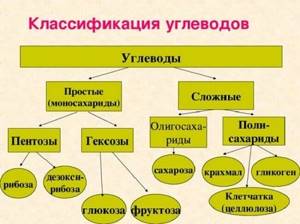
What products contain
Only carbohydrate can go into glycogen. Therefore, it is extremely important to keep the carbohydrate level in your diet at least 50% of the total calories. By consuming a normal level of carbohydrates (about 60% of the daily diet), you preserve your own glycogen to the maximum and force the body to oxidize carbohydrates very well.
It is important to have baked goods, cereals, cereals, various fruits and vegetables in your diet.
The best sources of glycogen are: sugar, honey, chocolate , marmalade, jam, dates, raisins, figs, bananas , watermelon, persimmon, sweet pastries.
Persons with liver dysfunction and enzyme deficiency should be wary of such foods.
